Abstract
Previous chemical studies attempting to demonstrate Ia antigens on mouse thymocytes have given contradictory results. We attempted to resolve the question of whether Ia antigens exist on thymocytes (defined as thymus cells that bear a T cell marker) by isolating strain C3H thymocytes free of other contaminating cells using the fluorescence-activated cell sorter, and then chemically testing the purified populations for Ia antigens. Immunoglobulin-negative thymus cells and thymus cells selected with a rabbit antiserum to mouse brain were the two populations of thymocytes labeled with [3H]leucine after sorting. Radiolabeled proteins were solubilized with the non-ionic detergent Nonidet P-40, reacted with anti-Ia antiserum, and analyzed by electrophoresis on discontinuous sodium dodecyl sulfate/polyacrylamide gels. Ia antigens were recovered from both cell populations. These antigens were synthesized by thymocytes and were found on molecules composed of two chains of molecular weight 33,000 and 25,000, respectively, similar to Ia antigens derived from spleen cells. Assuming that all thymocytes bear similar amounts of Ia antigens, we estimated that they have approximately 1/50 the amount of Ia antigens that spleen cells do.
Full text
PDF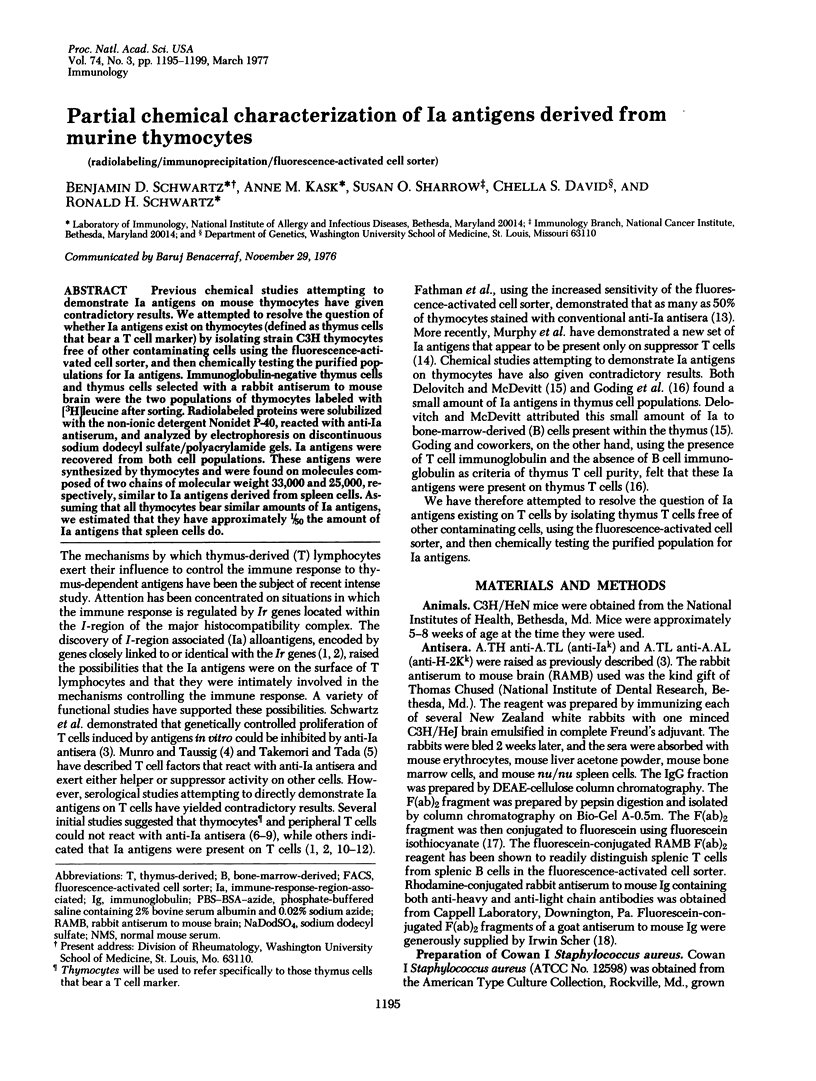
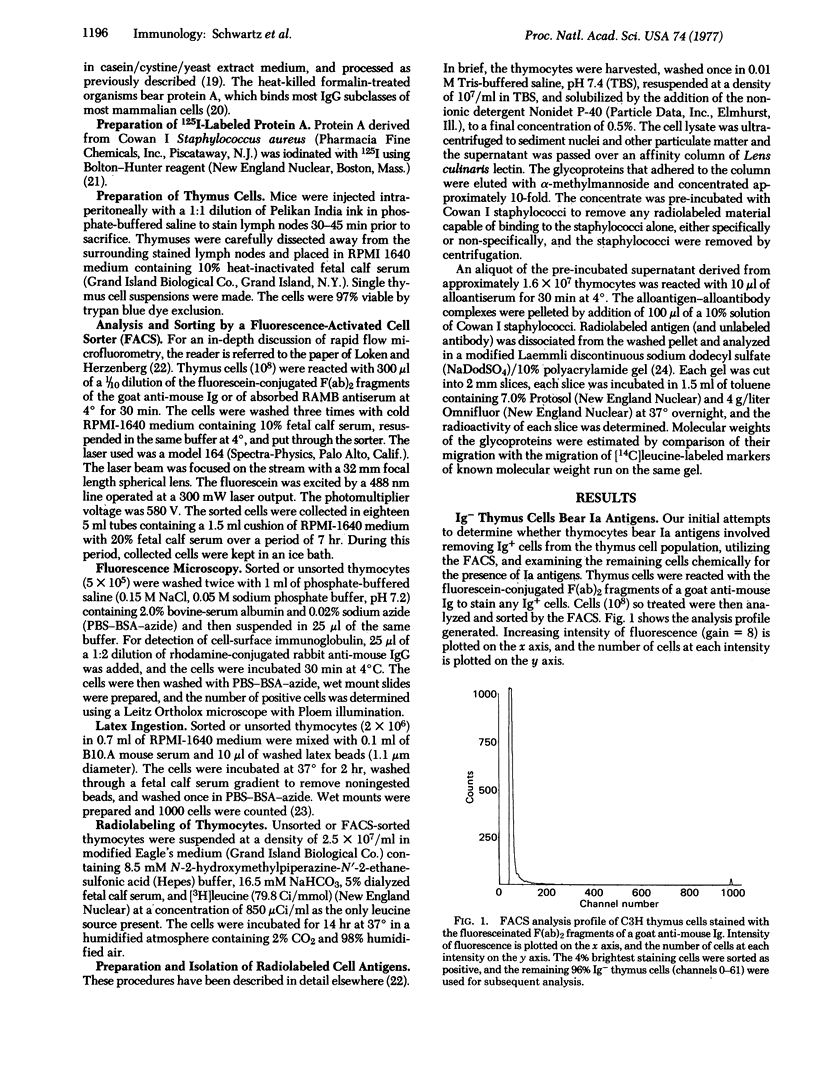
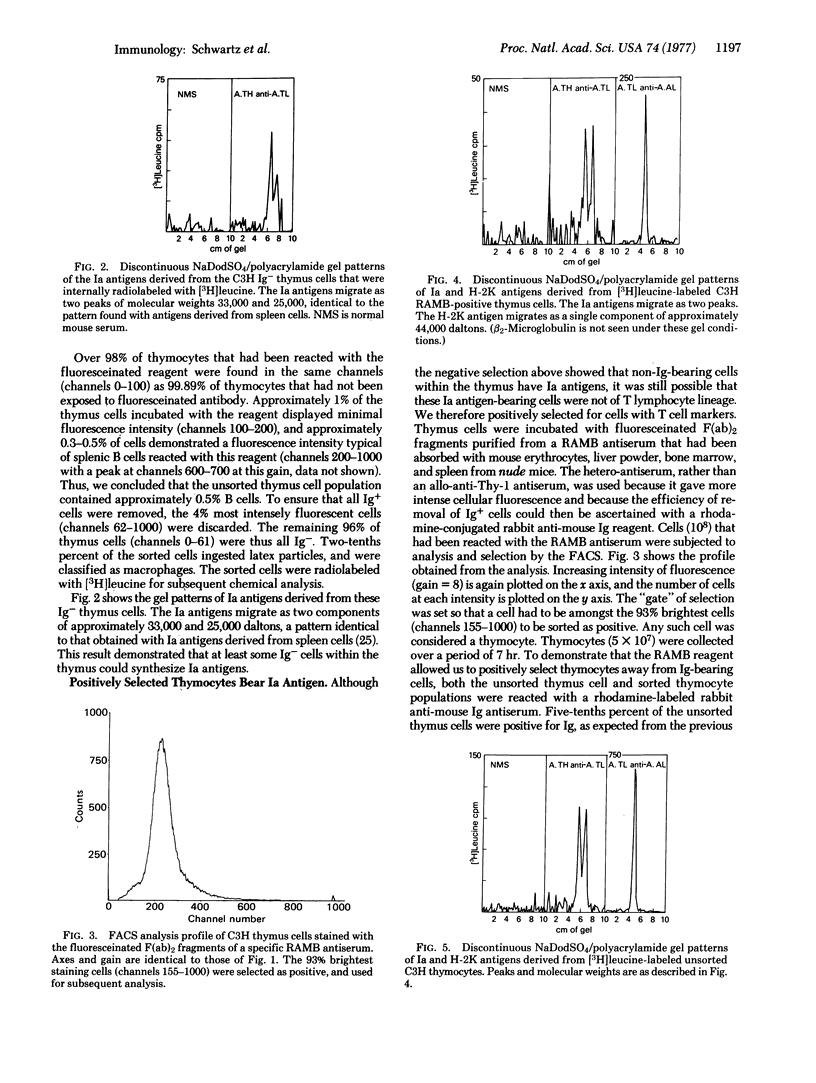
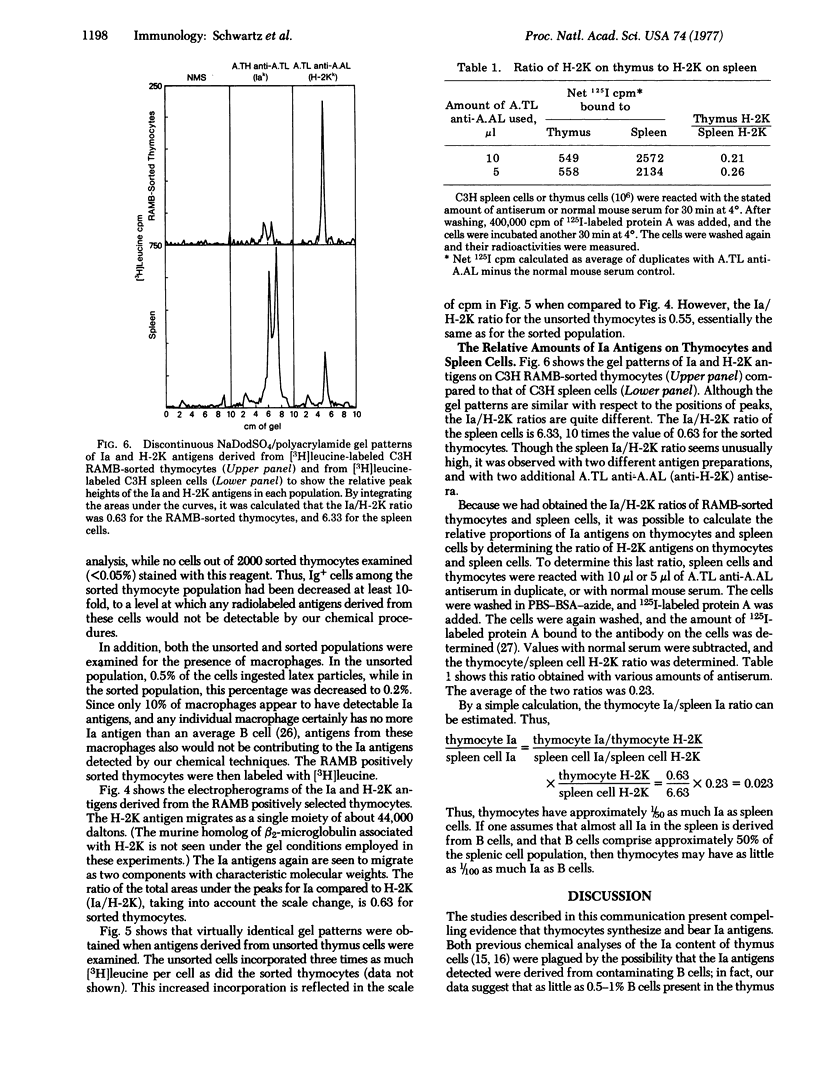
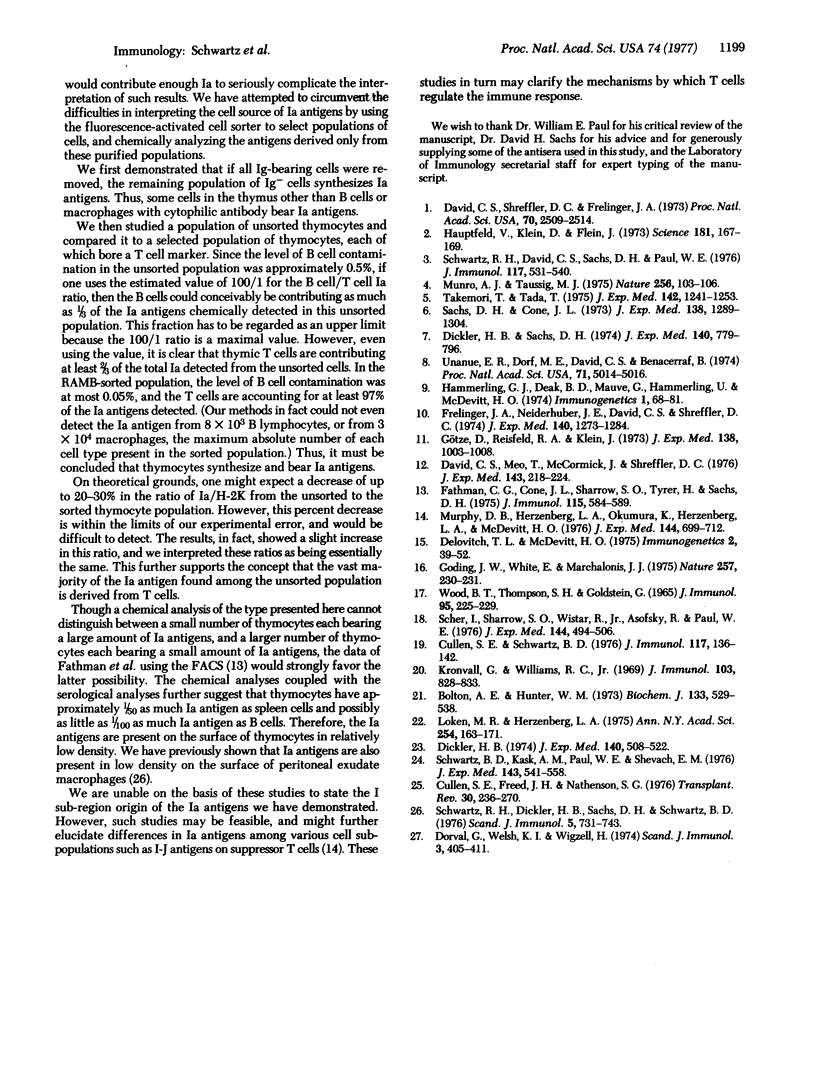
Selected References
These references are in PubMed. This may not be the complete list of references from this article.
- Bolton A. E., Hunter W. M. The labelling of proteins to high specific radioactivities by conjugation to a 125I-containing acylating agent. Biochem J. 1973 Jul;133(3):529–539. doi: 10.1042/bj1330529. [DOI] [PMC free article] [PubMed] [Google Scholar]
- Cullen S. E., Freed J. H., Nathenson S. G. Structural and serological properties of murine Ia alloantigens. Transplant Rev. 1976;30:236–270. doi: 10.1111/j.1600-065x.1976.tb00222.x. [DOI] [PubMed] [Google Scholar]
- Cullen S. E., Schwartz B. D. An improved method for isolation of H-2 and Ia alloantigens with immunoprecipitation induced by protein A-bearing staphylococci. J Immunol. 1976 Jul;117(1):136–142. [PubMed] [Google Scholar]
- David C. S., Shreffler D. C., Frelinger J. A. New lymphocyte antigen system (Lna) controlled by the Ir region of the mouse H-2 complex. Proc Natl Acad Sci U S A. 1973 Sep;70(9):2509–2514. doi: 10.1073/pnas.70.9.2509. [DOI] [PMC free article] [PubMed] [Google Scholar]
- David C., Meo T., McCormick J., Shreffler D. Expression of individual Ia specificities on T and B cells. I. Studies with mitogen-induced blast cells. J Exp Med. 1976 Jan 1;143(1):218–224. doi: 10.1084/jem.143.1.218. [DOI] [PMC free article] [PubMed] [Google Scholar]
- Dickler H. B., Sachs D. H. Evidence for identity or close association of the Fc receptor of B lymphocytes and alloantigens determined by the Ir region of the H-2 complex. J Exp Med. 1974 Sep 1;140(3):779–796. doi: 10.1084/jem.140.3.779. [DOI] [PMC free article] [PubMed] [Google Scholar]
- Dickler H. B. Studies of the human lymphocyte receptor for heat-aggregated or antigen-complexed immunoglobulin. J Exp Med. 1974 Aug 1;140(2):508–522. doi: 10.1084/jem.140.2.508. [DOI] [PMC free article] [PubMed] [Google Scholar]
- Dorval G., Welsh K. I., Wigzell H. Labeled staphylococcal protein A as an immunological probe in the analysis of cell surface markers. Scand J Immunol. 1974;3(4):405–411. doi: 10.1111/j.1365-3083.1974.tb01273.x. [DOI] [PubMed] [Google Scholar]
- Fathman C. G., Cone J. L., Sharrow S. O., Tyrer H., Sachs D. H. Ia alloantigen(s) detected on thymocytes by use of a fluorescence-activated cell sorter. J Immunol. 1975 Aug;115(2):584–589. [PubMed] [Google Scholar]
- Frelinger J. A., Neiderhuber J. E., David C. S., Shreffler D. C. Evidence for the expression of Ia (H-2-associated) antigens on thymus-derived lymphocytes. J Exp Med. 1974 Nov 1;140(5):1273–1284. doi: 10.1084/jem.140.5.1273. [DOI] [PMC free article] [PubMed] [Google Scholar]
- Goding J. W., White E., Marchalonis J. J. Partial characterisation of Ia antigens on murine thymocytes. Nature. 1975 Sep 18;257(5523):230–231. doi: 10.1038/257230a0. [DOI] [PubMed] [Google Scholar]
- Götze D., Reisfeld R. A., Klein J. Serologic evidence for antigens controlled by the Ir region in mice. J Exp Med. 1973 Oct 1;138(4):1003–1008. doi: 10.1084/jem.138.4.1003. [DOI] [PMC free article] [PubMed] [Google Scholar]
- Hauptfeld V., Klein D., Klein J. Serological identification of an Ir-region product. Science. 1973 Jul 13;181(4095):167–169. doi: 10.1126/science.181.4095.167. [DOI] [PubMed] [Google Scholar]
- Kronvall G., Williams R. C., Jr Differences in anti-protein A activity among IgG subgroups. J Immunol. 1969 Oct;103(4):828–833. [PubMed] [Google Scholar]
- Loken M. R., Herzenber L. A. Analysis of cell populations with a fluorescence-activated cell sorter. Ann N Y Acad Sci. 1975 Jun 30;254:163–171. doi: 10.1111/j.1749-6632.1975.tb29166.x. [DOI] [PubMed] [Google Scholar]
- Munro A. J., Taussig M. J. Two genes in the major histocompatibility complex control immune response. Nature. 1975 Jul 10;256(5513):103–106. doi: 10.1038/256103a0. [DOI] [PMC free article] [PubMed] [Google Scholar]
- Murphy D. B., Herzenberg L. A., Okumura K., Herzenberg L. A., McDevitt H. O. A new I subregion (I-J) marked by a locus (Ia-4) controlling surface determinants on suppressor T lymphocytes. J Exp Med. 1976 Sep 1;144(3):699–712. doi: 10.1084/jem.144.3.699. [DOI] [PMC free article] [PubMed] [Google Scholar]
- Sachs D. H., Cone J. L. A mouse B-cell alloantigen determined by gene(s) linked to the major histocompatibility complex. J Exp Med. 1973 Dec 1;138(6):1289–1304. doi: 10.1084/jem.138.6.1289. [DOI] [PMC free article] [PubMed] [Google Scholar]
- Scher I., Sharrow S. O., Wistar R., Jr, Asofsky R., Paul W. E. B-lymphocyte heterogeneity: ontogenetic development and organ distribution of B-lymphocyte populations defined by their density of surface immunoglobulin. J Exp Med. 1976 Aug 1;144(2):494–506. doi: 10.1084/jem.144.2.494. [DOI] [PMC free article] [PubMed] [Google Scholar]
- Schwartz B. D., Kask A. M., Paul W. E., Shevach E. M. Structural characteristics of the alloantigens determined by the major histocompatibility complex of the guinea pig. J Exp Med. 1976 Mar 1;143(3):541–558. doi: 10.1084/jem.143.3.541. [DOI] [PMC free article] [PubMed] [Google Scholar]
- Schwartz R. H., David C. S., Sachs D. H., Paul W. E. T lymphocyte-enriched murine peritoneal exudate cells. III. Inhibition of antigen-induced T lymphocyte Proliferation with anti-Ia antisera. J Immunol. 1976 Aug;117(2):531–540. [PubMed] [Google Scholar]
- Schwartz R. H., Dickler H. B., Sachs D. H., Schwartz B. D. Studies of Ia antigens on murine peritoneal macrophages. Scand J Immunol. 1976;5(6-7):731–743. doi: 10.1111/j.1365-3083.1976.tb03023.x. [DOI] [PubMed] [Google Scholar]
- Takemori T., Tada T. Properties of antigen-specific suppressive T-cell factor in the regulation of antibody response of the mouse. I. In vivo activity and immunochemical characterization. J Exp Med. 1975 Nov 1;142(5):1241–1253. doi: 10.1084/jem.142.5.1241. [DOI] [PMC free article] [PubMed] [Google Scholar]
- Unanue E. R., Dorf M. E., David C. S., Benacerraf B. The presence of I-region-associated antigens on B cells in molecules distinct from immunoglobulin and H-2K and H-2D. Proc Natl Acad Sci U S A. 1974 Dec;71(12):5014–5016. doi: 10.1073/pnas.71.12.5014. [DOI] [PMC free article] [PubMed] [Google Scholar]
- Wood B. T., Thompson S. H., Goldstein G. Fluorescent antibody staining. 3. Preparation of fluorescein-isothiocyanate-labeled antibodies. J Immunol. 1965 Aug;95(2):225–229. [PubMed] [Google Scholar]


